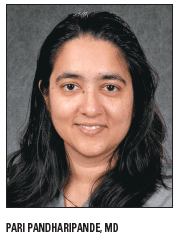Decision-analytic model aids cervical cancer treatment
Imaging with MR and/or PET/CT can help physicians figure out appropriate treatment for cervical cancer patients as well as prevent unnecessary therapy, according to a new study.
ABSTRACT: Overtreatment in cervical cancer poses a conundrum. Boston-based researchers explain how their PET/CT decision model can triage patients to the correct therapy.
Imaging with MR and/or PET/CT can help physicians figure out appropriate treatment for cervical cancer patients as well as prevent unnecessary therapy, according to a new study.

When it comes to treating patients with cervical cancer there are two options. The first is surgery with or without postoperative adjuvant chemoradiation (chemotherapy and radiation therapy). The second is primary chemoradiation.
One of the problems to date, however, is overtreatment, which has not been studied well in the literature and should become a factor in deciding how to stage people up front, according to the study’s lead author Pari Pandharipande, MD, from Boston’s Institute for Technology Assessment and Massachusetts General Hospital (MGH).
In their decision-analytic model, the researchers found PET/CT performed better than MRI across all outcomes as a stand-alone strategy and was preferred to other strategies for triaging patients to the correct primary therapy (Am J Roentgenol 192:802-814, 2009).
The researchers developed the model to predict outcomes for a hypothetical patient cohort using International Federation of Gynecology and Obstetrics standards for IB cervical cancer patients who underwent pretreatment MRI, PET/CT, MRI and PET/CT, or no imaging.
Dr. Pandharipande and her team compared five-year overall survival, the percentage of patients receiving correct primary therapy, and the percentage of patients spared trimodality therapy (surgery followed by chemoradiation).

Results
Five-year survival was highest with no imaging at 92.37%, followed by PET/CT at 92.36%, and combined MRI and PET/ CT at 92.30%. PET/CT had the highest percentage of triage to correct primary therapy at 89.27% and MRI (alone) had the lowest with 68.21%. MRI combined with PET/CT resulted in the highest rate of avoidance of trimodality therapy (95%), while the lowest rate occurred when patients weren’t imaged at all (82.32%).
While a combined MRI and PET/CT strategy is preferable when it comes to avoiding trimodality therapy, for some patients avoiding trimodality therapy may not be the primary goal.
“If the study had shown there was one particular staging strategy that was best no matter what the outcome of interest was -survival, triage to optimal therapy, or reduction of overtreatment-then it would be, in a way, simpler,” Dr. Pandharipande told Oncology News International.
“What we found at this point is that these staging decisions still need to be made at the individual patient level,” she explained.
Performance and patients
Essentially, the study highlights what information to consider in each scenario, according to Dr. Pandharipande.
Many radiology studies focus on test performance : What is a modality’s sensitivity and specificity? Th is is important information during the development, implementation, and evaluation of the widespread use of an imaging technique.
“The next step is how does it aff ect patients down the line? And that’s where my body of research is centered,” she said.
Dr. Pandharipande’s coauthors for this study were Garry Choy, MD, Marcela G. del Carmen, MD, MPH, and G. Scott Gazelle, MD, PhD, from MGH’s department of gynecologic oncology; Anthony H. Russell, MD, from the department of radiation oncology; and Susana I. Lee, MD, from the department of radiology.
Related research
Other recent studies have also assessed the value of MRI and/or PET/CT in gynecologic malignancies.
Researchers from Asan Medical Center at the University of Ulsan in Seoul, South Korea, performed a node-by-node comparison of apparent diffusion coefficientbased diagnosis (ADC) and size-based criteria on T2-weighted MRI with PET/ CT findings in 163 patients with uterine cervical cancer (330 pelvic lymph nodes). They found that the ADC-enhanced MRI showed better correlation with PET/CT (Eur Radiol online, March 11, 2009).
Julie K. Schwarz, MD, and colleagues at Washington University in St. Louis and Vanderbilt University in Nashville, Tenn., determined that the addition of FDGPET/ CT to the evaluation of patients with locally advanced cervical cancer changed management in approximately one-third of the cases, and reduced overall treatment costs by accurately identifying which patients would benefit from surgery.
Dr. Schwarz is from the department of radiation oncology as is coauthor Perry W. Grigsby, MD. Coinvestigator Farrokh Dehdashti, MD, is from the Alvin J. Siteman Cancer Center at Washington University while Dominique Delbeke, MD, is from Vanderbilt.

PET/CT may also be promising for early prediction of response to chemotherapy and for prediction of response after the completion of chemotherapy, they said.
Dr. Schwarz’s group pointed out that PET and PET/CT studies are generally most helpful in the evaluation of patients with suspected recurrent ovarian carcinoma, especially when CA-125 levels are rising (J Nucl Med online, April 20, 2009).